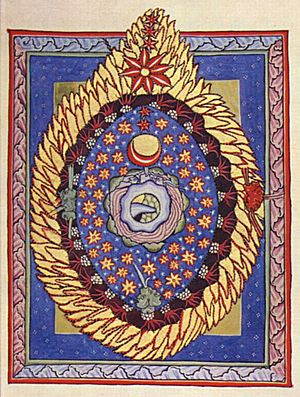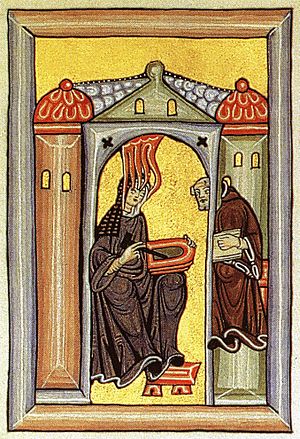Scivias facts for kids
Scivias is a famous book written by a remarkable woman named Hildegard of Bingen. She completed it around 1151 or 1152. The book describes 26 special religious visions that Hildegard experienced. It was the first of three books she wrote about her visions. The name Scivias comes from a Latin phrase meaning "Know the Ways of the Lord." The book has 35 beautiful miniature pictures, which is more than her later vision books.
Scivias is divided into three main parts, like the Trinity (God the Father, Son, and Holy Spirit). The first two parts are about the same length. The third part is as long as the first two combined!
- Part One has six visions. It talks about how the world was created and the Fall (when humans first disobeyed God).
- Part Two has seven visions. It focuses on how people can be saved through Jesus Christ, the Church, and special ceremonies called sacraments.
- Part Three has thirteen visions. It describes the future kingdom of God, becoming holy, and the ongoing fight between good and evil.
The very last vision in the book includes 14 songs. It also has a part of a music play called Ordo Virtutum. For each vision, Hildegard first wrote down what she saw. Then, she wrote down the explanations she heard, which she believed came from "the voice of heaven."
Contents
Finding and Reading Scivias
Scivias has survived in ten old copies from the Middle Ages. Sadly, two of these copies have been lost in modern times.
The Rupertsberg Manuscript
The most important copy was the Rupertsberg manuscript. It was made around the time Hildegard died. She might have even watched it being made! This special book was kept safe in Wiesbaden for a long time. During World War II, it was moved to Dresden for safety but then got lost. Even after German reunification in 1990, it has not been found. We only have black-and-white photos of this original book.
The original manuscript was quite large, about 12.8 by 9.25 inches. It had 235 parchment pages.
Modern Copies and Translations
Luckily, a very good illuminated copy was made at the Hildegard Abbey in Eibingen between 1927 and 1933. This copy is the source of the colorful pictures we see today. Other old copies are kept in places like the Vatican Library and Oxford.
The first modern translation of Scivias into German was published in 1928. Today, Scivias is one of Hildegard's books that is easiest for people to find and read in different languages.
How Hildegard Wrote the Book
Hildegard wrote in the preface of Scivias that in 1141, when she was 42 years old, God told her in a vision to share her religious experiences. At this time, she had been the leader (called an superior) of a group of women at Disibodenberg for five years.
Starting to Write
Hildegard had been seeing visions since she was five years old. But she had only told a monk named Volmar and her old superior, Jutta, who had passed away. She felt unsure about writing down her visions. She might have felt too humble or simply scared. When she got sick, she believed it was a punishment from God because she was hesitating.
Volmar told her she had to write her visions down. He and one of her nuns, Richardis von Stade, helped her write the book. She also got permission from the Abbot Kuno at Disibodenberg. She even wrote to Bernard of Clairvaux for advice in 1146. He agreed that her visions seemed to be from God and said he wouldn't interfere with God's commands. It took her a while to decide to write, even with encouragement, which shows how scary these visions might have been for her.
Papal Approval and Moving
A group from Disibodenberg took some of Hildegard's writings to a big meeting called the Synod of Trier in 1147-1148. Her writings were read aloud there. Pope Eugene III gave his approval for Hildegard's writings. He also gave her permission to publish everything she received in her visions. We don't know if the pictures that go with the text were shown at this meeting.
In 1148, Hildegard had another vision. This one told her to move her convent to Rupertsberg. She moved there in 1150 and finished Scivias soon after, in 1151 or 1152.
The Illustrations
It's not completely clear what Hildegard's role was in creating the book's illustrations. Some experts think she wasn't involved at all. Others think she told people what to draw. Some even believe she drew them herself. In one picture at the beginning of the book, Hildegard is shown drawing on a wax tablet while telling Volmar about a vision. Some scholars think she might have sketched the basic ideas of her visions. Then, others would have added the details later.
What Scivias is About
The book is divided into three main sections. Each section begins and ends with a special phrase that shows it's a prophetic (future-telling) work. Also, each vision ends with a special sentence. These sentences are different for each of the three sections:
- In Part One, the ending sentence is: "I heard again the voice from heaven speaking to me."
- In Part Two, it's: "And again I heard a voice from the heavenly heights speaking to me."
- In Part Three, it's: "And I heard that light who sat on the throne speaking."
The Songs in Scivias
The fourteen songs in the last vision are special types of church songs. The words are written in a mysterious style. The songs are arranged in pairs, based on their subject. There are two songs for the Virgin Mary, two for the angels, and two for each of five groups of saints: patriarchs and prophets, apostles, martyrs, confessors, and virgins.
The connection between the visions and the music at the end of the book is not fully understood. Some experts believe Hildegard designed the visions, songs, and play to be part of an educational program. If this is true, it's the only such program that still exists from the Middle Ages.
Influence of Scivias
In Hildegard's time, Scivias was her most famous work. Another nun, Elizabeth of Schönau, used Scivias as a guide for her own book, Liber viarum Dei. Elizabeth also had visions, and Hildegard encouraged her to publish them.
The Ordo Virtutum, which is part of Scivias, is the earliest known morality play. Before this, people thought this type of play started much later, in the 14th century.
Images for kids
See also
 In Spanish: Scivias para niños
In Spanish: Scivias para niños




